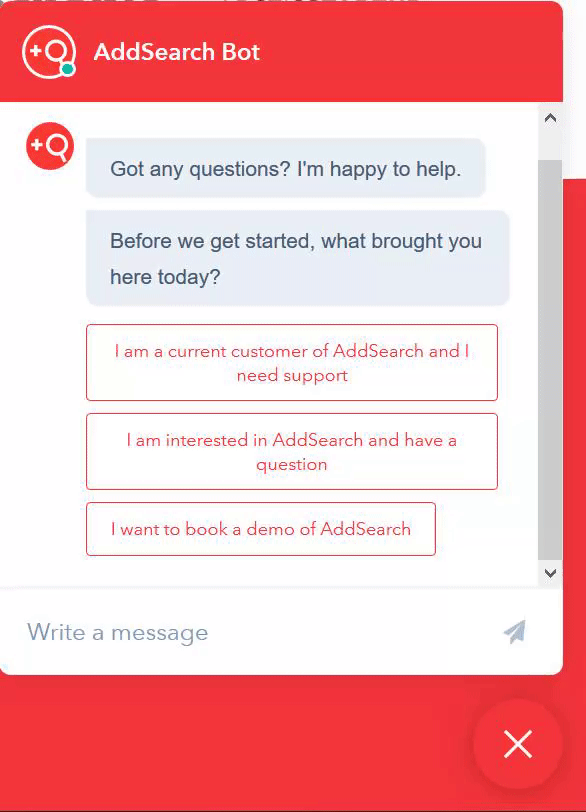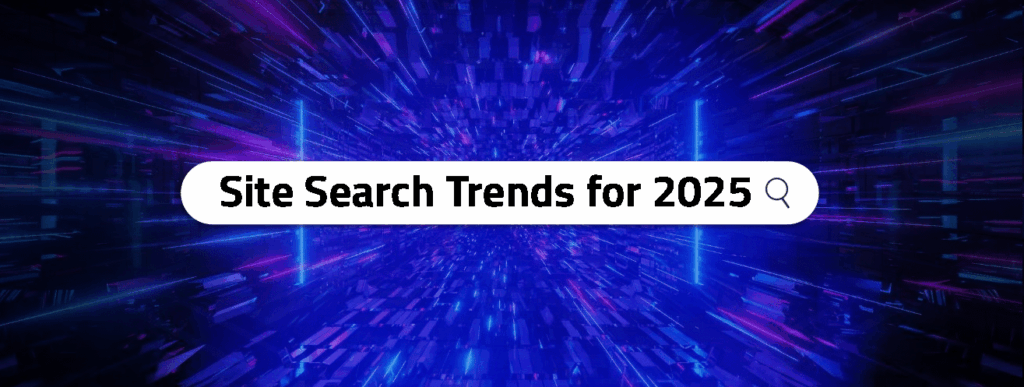Site search has proven itself integral to reaching higher conversions on websites. Nowadays the question is not whether you have a site search function but rather how well it is working.
For 2025, just as in 2024, the emerging site search trends appear to be focused towerds making the user experience more intuitive and accessible. Keep reading if you want to know where the site search industry is going, how it could affect your business, and how you could use a site search solution to get even more customers.
1. AI and Machine Learning enhancements
As we approach 2025, the role of AI and machine learning in site search is becoming increasingly significant. These technologies are evolving to offer more than just basic keyword matching; they’re transforming how site searches interpret and respond to user queries.
The advancement in AI enables a more nuanced understanding of search queries. Machine learning algorithms, which improve through user interaction, are now adept at discerning the intent behind a search. This isn’t just about delivering relevant results; it’s about creating a search experience that aligns with the user’s specific needs and context.

Personalization is a significant benefit of this advancement. The search experience becomes tailored to individual users, with the engine adapting its responses based on their browsing habits and preferences. This level of customization enhances user engagement, making interactions with the search platform more efficient and satisfying.
For businesses, the advantages of AI-enhanced site search reach new heights, impacting not just insights and analytics but also driving conversions and reducing bounce rates. These advanced tools excel in presenting highly relevant and personalized search results, significantly boosting user engagement. This relevance means users are more likely to quickly find what they’re seeking, increasing the chances of a purchase or interaction with content.
Moreover, AI-driven search opens doors to discovery. It skillfully presents products, services, or content that users might not have initially sought but find highly relevant or intriguing. This aspect of discovery enriches the user experience, leading to increased exploration and engagement on the site. Users stay engaged longer, not just because they find what they need, but because they’re introduced to new, relevant content that resonates with their interests and needs.
The result is a dual benefit: a streamlined, intuitive search experience that reduces frustration and bounce rates, and a discovery-rich environment that encourages exploration and spending more time on the site. In short, AI-driven site search is a potent tool for not just understanding but actively shaping customer behavior, leading to enhanced business outcomes.

“Explore the power of AI in search! Read our latest blog on ‘AI Search: Bridge to Effortless Interactions’ for key insights.
[hubspot type=cta portal=5694604 id=ade3f7b1-5b67-4bf6-9bce-9207aa39d725]
2. Your site search can no longer offer zero results pages
When users search on your site, they might not find what they’re looking for if their keywords don’t match your product labeling. For example, in an eCommerce store selling footwear, a customer searching for ‘thongs’ might end up with no results if those items are listed as ‘flip flops’ or ‘sandals.’ This can be frustrating and highlights why accurate and relevant search results are crucial. In fact, 80% of consumers leave a website due to poor search experiences, making it clear that matching search terms with product listings is essential for customer satisfaction.
A zero result page for your user means a lost client for you. Fortunately, features like AddSearch’s auto synonyms help prevent zero-result pages by adding synonyms for search terms that yield no results, enhancing search accuracy. For example, if a user searches for “cell phone cases” but your site uses “mobile phone covers,” the system will recognize and bridge this terminology gap, ensuring users find what they need.
3. Voice Search and Natural Language Processing
Voice search and natural language processing (NLP) are reshaping online interactions, especially in site search. As of 2025, these technologies cater to a significant portion of online searches, influenced by the convenience and speed they offer.

A compelling statistic indicates that around 125.2 million of the global online population uses voice search services, reflecting its widespread adoption. This growing usage highlights the shift towards voice as a preferred search medium.
The increasing use of digital assistants like Siri, which has been tried by an astounding 98% of iPhone users, exemplifies the popularity and integration of voice search in everyday life. With Google Assistant and Siri each capturing the loyalty of 36% of users, it’s evident that voice search is becoming a mainstream mode of online interaction.
Businesses must adapt to this trend by optimizing their site content for voice queries. This involves focusing on natural language and question-based queries, which are more common in voice searches.
4. Site search will feel less like search and more intuitive
A good site search is the one you do not even think about as a user. You use it so intuitively that you don’t need to assess what you are doing – you just do it. In 2025, site search will look even less like classical search.
Search engines will become more capable of anticipating users’ needs by analyzing data on user behavior and search trends.
An excellent example of this shift away from traditional search to intelligent search is AddSearch’s Progressive Ranking feature, which employs AI to discern patterns in user behavior and adapt accordingly. For instance, in the context of a fashion retailer, a search for “shoes” might yield preferences for sneakers in summer and boots in winter. Progressive Ranking automatically recognizes these shifts in user behavior, promoting results that align with current trends and ensuring that the most relevant and popular items are prominently displayed in search results. This technology leverages collective user behavior to boost high-converting content, ensuring that your search results remain relevant and attuned to the evolving preferences of your audience.
5. Mobile-First Search Experience
In 2025, it’s all about mobile when it comes to searching online. More than half of web traffic now comes from mobile devices, which tells us a lot about how people search for information and products. For businesses, this means one thing: your website’s search function needs to work really well on mobile.
The importance of mobile search is even bigger in online shopping. With 73% of all e-commerce sales happening on mobile, it’s clear that a lot of people are using their phones to search and buy products. This makes it essential for businesses to have a search feature on their websites that is easy to use on a smaller screen.
But what does a good mobile search experience include? It’s more than just ensuring your website fits on a smaller screen. It means having search buttons that are easy to tap and ensuring your search results load quickly and are easily viewable, no matter the screen size.
A well-optimized mobile search not only helps keep visitors on your site but also makes them more likely to recommend your business to others. In fact, 61% of internet users say they’re more likely to suggest a business with a mobile-friendly website.
In short, focusing on a mobile-first search experience is essential. With most searches now happening on mobile, your business needs to ensure its website’s search function works well on these devices. This isn’t just about following a trend; it’s about meeting your customers’ needs and improving their experience on your site.
6. A greater focus on security and privacy
The importance of privacy in site search continues to grow, driven by increased consumer awareness and evolving data privacy regulations. Statistics indicate that 45% of websites utilize cookie tracking, while a substantial portion of consumers view the handling of personal data as indicative of a company’s respect for its clientele.
In this context, tools like Global Privacy Control (GPC) are simplifying consumer privacy management across various websites. Additionally, in the U.S., state laws such as the California Consumer Privacy Act (CCPA) and upcoming federal laws like the American Data Privacy and Protection Act (ADPPA) compel businesses to adopt stringent privacy measures.

Incorporating SOC2 compliance into site search tools is essential for businesses. SOC2 is a framework that ensures data security, focusing on principles like security, availability, processing integrity, confidentiality, and privacy. This compliance is crucial not just for adhering to legal requirements but also for demonstrating a commitment to data security and consumer privacy.
With 84% of customers preferring brands that showcase strong security controls, and 76% reluctant to engage with companies they distrust with their data, prioritizing privacy in site search is a strategic necessity. It’s more than compliance; it’s about establishing trust and ensuring that user interactions, particularly in search functionalities, are secure and private.
7. Search will (continue to) actively support e-commerce
Global e-commerce retail is expected to reach a value of $6.3 trillion by 2024. Given the worldwide shift away from brick and mortar stores toward either hybrid or online fulfillment models, consumers have more options and more content to search through.
As observed in our 1st trend, search is adapting to this growth by employing machine learning and artificial intelligence to learn from customer behavior.
The search analytics that you get from site search will allow you insight not only into seasonality but also into consumer wants and trends. This presents an opportunity to constantly keep your customers’ needs at the center of your business strategy.
8. Site Search will support users through chatbots and conversational widgets
In 2025, chatbots in site search are becoming essential tools for businesses. The global chatbot market, already at USD 2.9 billion, is expected to grow to USD 10.5 billion by 2026. This growth is driven by chatbots’ efficiency and their ability to cut costs in customer service. For instance, they can reduce customer service expenses by up to 30%, which resulted in billions in savings for businesses in recent years.
Chatbots are popular across various demographics, especially among younger consumers like Generation Z, who prefer using chatbots for initial customer service interactions. This shift indicates a growing preference for quick, tech-driven solutions over traditional methods.
The impact of chatbots is felt across multiple sectors:
- Finance and Healthcare: They streamline processes, improving efficiency and customer satisfaction.
- Retail and E-commerce: Chatbots have boosted sales conversions, in some cases by up to 70%.
- Hospitality and Travel: They enhance customer experiences by facilitating faster services and providing information efficiently.
Also, Check:
Convert Travel Browsers to Bookers with AddSearch Recommend
Future trends suggest that chatbots will become more human-like due to advances in natural language processing and machine learning. This means more natural conversations and improved user experiences. Also, the rise of voice bots will make chatbot interactions even more accessible and varied.
How chatbots work
Chatbots search through the website and offer results based on the website’s search index (find out more about indexing). The user is not aware that they are using site search, even though the site search provides relevant information through search indexing and a chatbot.

Chatbot at AddSearch guides you towards the info you need.
For example, a real estate agency might offer a chatbot that asks users questions such as “How many bedrooms are you looking for?” or “What is your price range?” or “Are you interested in a house or an apartment?”. All of the information is already indexed, so the chatbot can offer relevant suggestions for the customer.
While chatbots give the answer to the client, the underlying technology used in this case is site search. Going back to our example of the real estate agency, a user looking for apartments in a certain area, can get a pop up from the chatbot when a new apartment in this area just came on the market.
Is there anything in this post that you’d like to understand better, or are there any topics you’d like to explore in more detail? Our team at AddSearch is here to help! Reach out if you have any questions or if you need further clarification on anything we’ve discussed.
9. Search and accessibility
In 2024, the focus on accessibility in site search is more critical than ever. With a significant portion of the population living with disabilities, ensuring digital accessibility has become a key priority for businesses and website developers.
Current data indicates that over 27% of the U.S. population lives with some form of disability, yet only less than 2% of American websites are fully accessible to people with disabilities. This gap highlights the urgent need for more inclusive and accessible digital environments. The push towards better web accessibility is not just a moral imperative but also a legal requirement in many regions. For example, the Americans with Disabilities Act (ADA) applies to web content, necessitating accessible website design for compliance.
Accessibility in site search and web design involves making websites usable for everyone, including those with disabilities like visual, cognitive, hearing, and mobility impairments. This encompasses aspects like screen reader compatibility, keyboard navigation, and clear, understandable content. For instance, ensuring that a site search is operable and understandable by users with various disabilities can significantly improve the user experience for a wider audience.
Digital accessibility laws are continuously evolving, with regions like the EU standardizing accessibility requirements across both physical and digital spaces. The European Accessibility Act, introduced in April 2019, requires adherence to standardized accessibility requirements across public and private sectors by June 28, 2024. Similarly, in Canada, the Accessible Canada Act and provincial laws like the Accessibility for Ontarians with Disabilities Act (AODA) mandate compliance with web accessibility standards.
In the context of site search, making search features accessible includes providing voice search capabilities for users who may have difficulty typing, offering alternative text for images, and ensuring that search results are easily navigable using assistive technologies. Additionally, predictive search features should be designed to accommodate users with various disabilities, providing relevant results in an accessible format.
Overall, as we progress into 2025, the importance of accessibility in site search cannot be overstated. It’s essential for businesses to understand and implement accessibility best practices not only to comply with legal requirements but also to provide an inclusive experience for all users, regardless of their abilities.
10. Site search providers will offer more elaborate ready-made tools
This is ideal for any company, from small to enterprise, that does not want to waste any time and personal resources on hiring a developer to code and customize their site search tool.
Site search companies like us at AddSearch will provide even more ready-made tools and example code for their customers to offer great search results with smaller effort and a smaller amount of resources. So far, ready-made tools offered simple solutions like a search box. To implement a more sophisticated and customized user interface, a customer used to code a search by themselves.
More and more complex solutions are now available inside the tool libraries of site search providers. They offer a custom experience for the user without the need for doing the custom design work.
Now you can provide great search results – minus the struggle of having to code yourself. For example, you can easily offer a variety of user interface components such as price filters or category filters when you run an eCommerce site.
The options to control your search are going to be much more elaborate than they used to be. In addition to all that, you can adjust your site search rankings based on your business needs (e. g. offer the most profitable products first or the ones with the biggest gross margin).
Needless to say that these ready-made tools and tool libraries cut down expenses and time-to-market for your products.
Whether you’re looking to improve your website’s search functionality or seeking to provide a more engaging user experience, AddSearch has the tools to help you succeed. Book a free demo to experience intelligent search firsthand.


